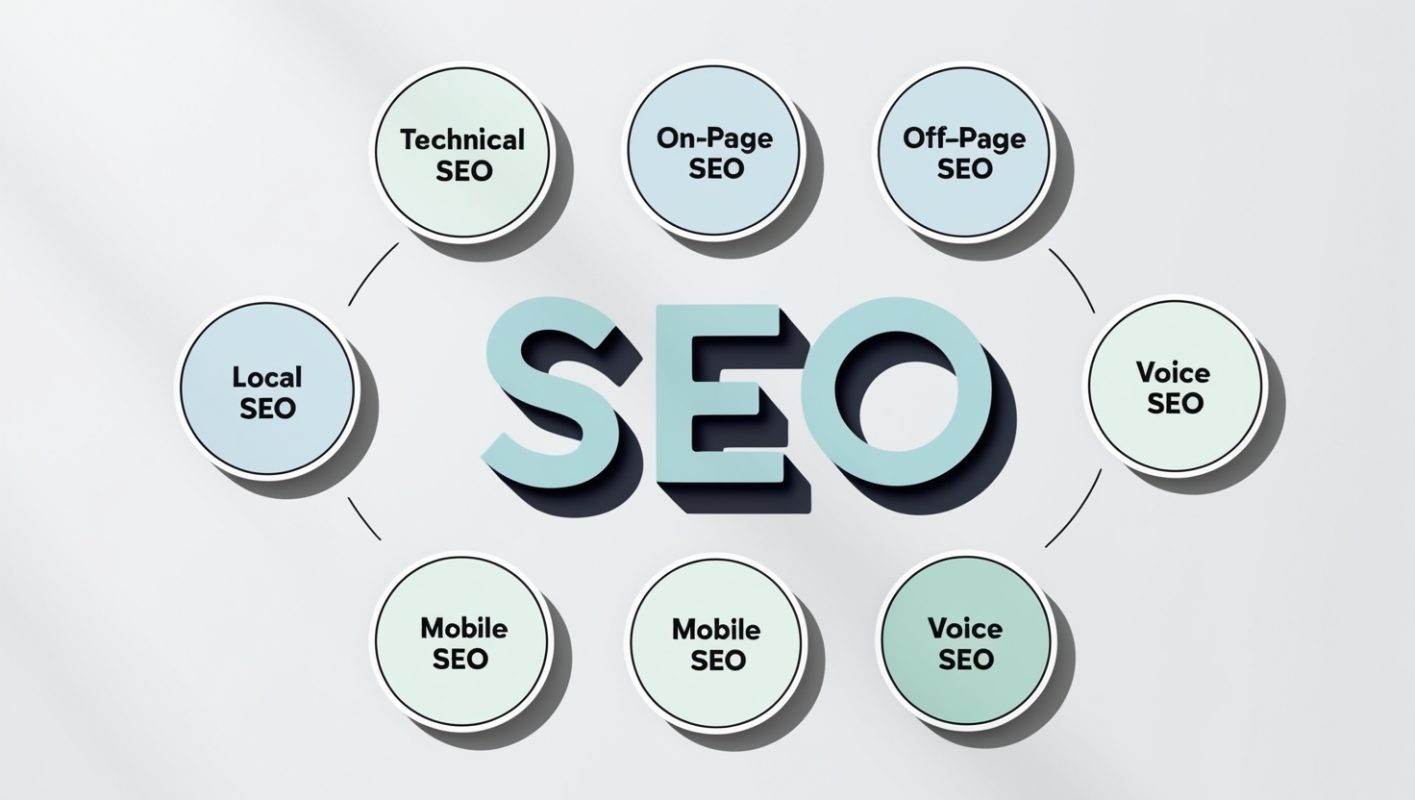
In the digital world today—where information is literally at your fingertips—it means to survive in business and to establish yourself uniquely online. That’s what search engine optimization can help you do. It improves visibility and relevance strategically for your website, which leads to an increase in organic traffic delivered seamlessly, thereby raising brand awareness, and leading to many more leads and sales.
Well, SEO only works according to one-size-fits-all solutions; it’s a complex strategy with many moving parts. To master SEO and leverage it for real tangible business benefits, it’s very important to understand the multifaceted nature of SEO. In this in-depth guide, we’re going to look closer at the different types of SEO and how each one works together toward your website’s overall success.
Let’s get started on this SEO adventure with Khan IT!
What is SEO? Experts Explanation About SEO
Search Engine Optimization, abbreviated to SEO, is the process whereby an existing website, or possibly one being built, is made more search engine-friendly. SEO grows rankings, drives more traffic through better on- and off-site optimization, and finally, maximizes conversions.
It is multifaceted in its field of activity, comprising many strategies and techniques geared toward improving quality and quantity from organic search results in site traffic.
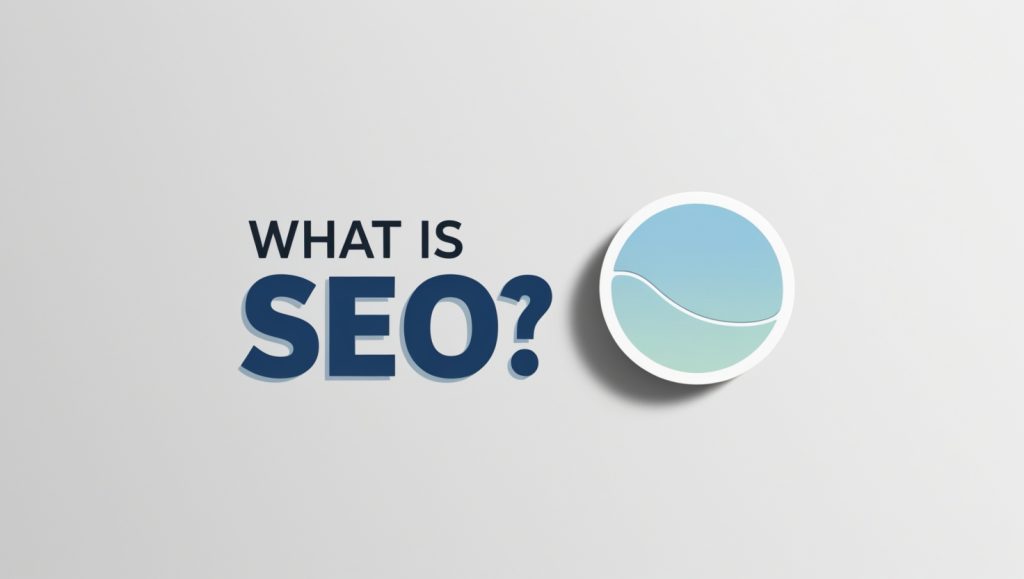
According to Neil Patel, a recognized authority in digital marketing, “SEO is the process of optimizing your online content so that a search engine likes to show it as a top result for searches of a certain keyword”.
This highlights that SEO isn’t just about improving visibility, but ensuring that your content is what search engines consider the best fit for specific queries.
It is not just about sprinkling keywords; SEO covers everything from technical optimizations to content strategy and user experience, among many others.
Moz, a trusted SEO platform, explains that “SEO is as much about people as it is about search engines themselves.” This demonstrates that creating a good user experience is key to successful SEO.
Knowing what to do and how to do SEO is crucial for keeping or improving your presence on the web, considering search engines change frequently. Google’s John Mueller, a well-known figure in SEO, advises that staying updated with changes in search algorithms is essential for maintaining a competitive edge.
Why Understanding Different Types of SEO is Important
Knowing the types of SEO will help businesses to have effective, result-oriented, and sustainable search engine rankings. Each type of SEO is focused on the specifics of your website and online presence. Having a comprehensive understanding of those areas, one can develop a well-rounded SEO strategy tailored towards the achievement of business goals.
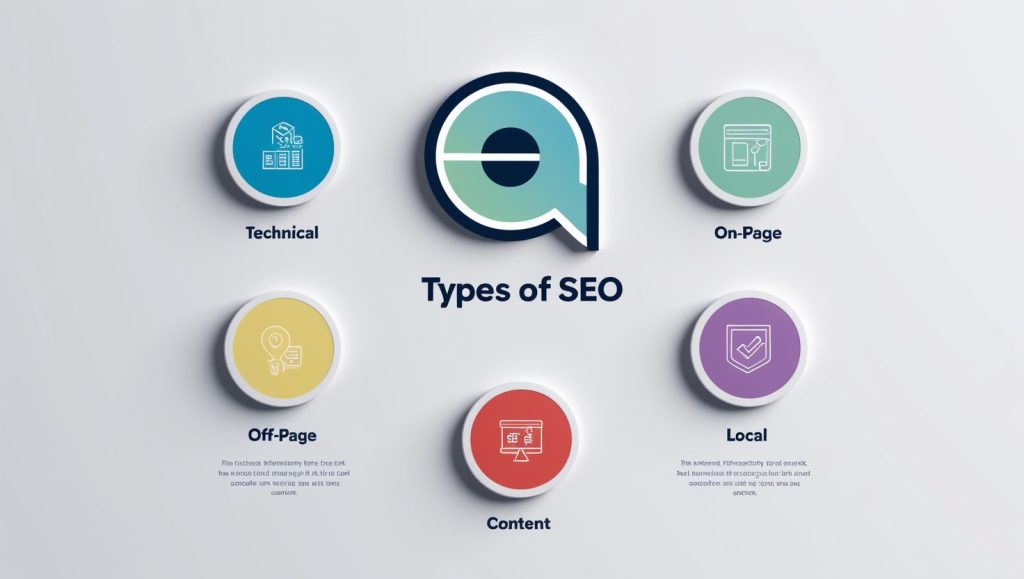
- Increased organic traffic: By implementing the right SEO strategies, you can boost your website’s visibility and attract more visitors naturally.
- Improved search engine rankings: Higher rankings on SERPs lead to increased credibility and trust among potential customers.
- Enhanced user experience: SEO is not just about search engines; it also focuses on improving the user experience, leading to higher engagement and satisfaction.
- Competitive advantage: Staying ahead of your competitors in search engine rankings can give you a significant edge in the market.
Mastering the kinds of SEO and their relevance can make a big difference in driving informed decisions on a digital marketing strategy toward long-term success.
Core Types of SEO
SEO is a huge area that has many strategies and techniques. However, it could broadly be classified into some core types. Here’s a short summarizing the core types of SEO :
| Type of SEO | Description | Key Strategies |
| On-Page SEO | Optimization is applied directly to the webpage for higher search rankings. | Title tags, meta descriptions, content optimization, internal linking, URL structure. |
| Off-Page SEO | External activities to improve search rankings and credibility. | Link building, social media engagement, influencer outreach, guest blogging, and online reputation management. |
| Technical SEO | Ensures website functionality for better user experience and search engine crawling. | Site speed, mobile-friendliness, crawlability, HTTPS security, fixing broken links. |
| Mobile SEO | Focuses on optimizing websites for mobile devices to improve user experience. | Responsive design, mobile-friendly navigation, page speed optimization, mobile usability, and local SEO. |
| JavaScript SEO | Optimizes websites that heavily use JavaScript for better search engine indexing. | Server-side rendering, dynamic rendering, SEO-friendly JavaScript frameworks, and performance optimization. |
Let’s explore these fundamental aspects of SEO:
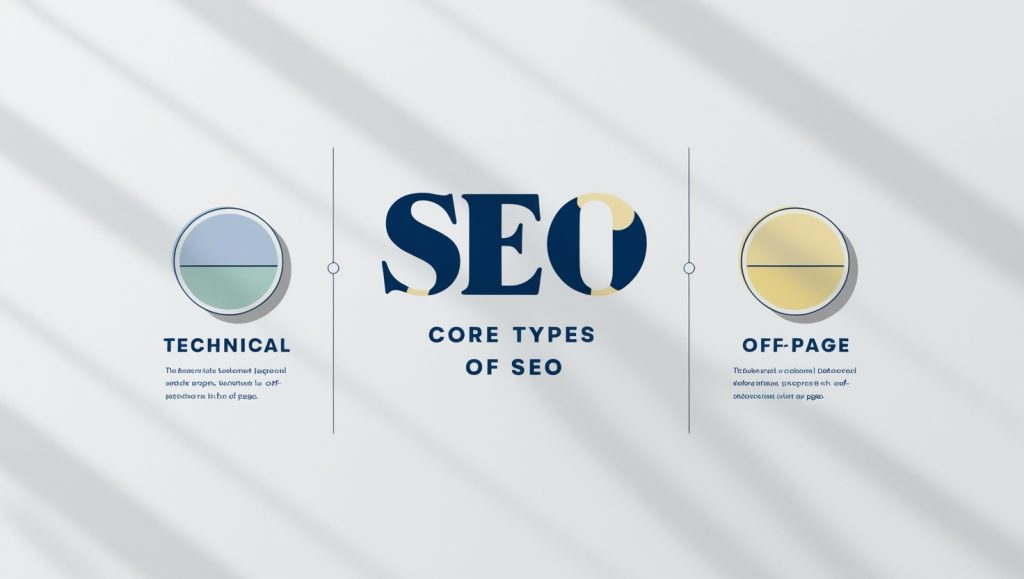
1. On-Page SEO
On-page SEO entails techniques applied directly to the webpage in its development or optimization to increase its ranking in a search engine. This may involve content optimization, meta tags, heading tags, internal links, etc., to make the page easily readable for both search engines and useful to users. Some of the critical elements of On-page SEO include:
- Title Tags and Meta Descriptions: Crafting compelling and relevant title tags and meta descriptions to improve click-through rates.
- Header Tags: Using H1, H2, and other header tags to structure content and highlight important sections.
- Content Optimization: Ensuring content is relevant, well-structured, and includes target keywords without keyword stuffing.
- URL Structure: Creating SEO-friendly URLs that are concise and include relevant keywords.
- Internal Linking: Linking to other relevant pages within your website to enhance navigation and distribute link equity.
2. Off-Page SEO
Off-page SEO refers to all activities done outside of your website to improve your rank within the search engines. Principally, it means structuring backlinks, and increasing authority and credibility for any site. The most important strategies are:
- Link Building: Acquiring high-quality backlinks from authoritative and relevant websites to improve domain authority.
- Social Media Engagement: SEO for SMM Panel services benefit from promoting content on social media platforms to increase visibility and drive traffic.
- Influencer Outreach: Collaborating with influencers to gain exposure and backlinks.
- Online Reputation Management: Monitoring and managing online reviews and mentions to build a positive brand image.
- Guest Blogging: Writing articles for other websites to earn backlinks and increase exposure.
3. Technical SEO
It’s the work done to ensure that your website, through the application of responsive design, navigation, mobile-friendliness, and page speed optimization, gives a smooth user experience across all kinds of screen sizes. Among the key aspects are:
- Site Speed: Improving page load times to enhance user experience and reduce bounce rates.
- Mobile-Friendliness: Ensuring your website is responsive and performs well on mobile devices.
- Crawlability: Using tools like robots.txt and sitemaps to guide search engines in crawling and indexing your site.
- HTTPS Security: Implementing HTTPS to secure your site and protect user data.
- Fixing Broken Links: Identifying and repairing broken links to avoid negatively impacting user experience and SEO.
4. Mobile SEO
It’s the work done to ensure that your website, through the application of responsive design, navigation, mobile-friendliness, and page speed optimization, gives a smooth user experience across all kinds of screen sizes. Among the key aspects are:
- Responsive Design: Ensuring your website layout adapts to various screen sizes and devices.
- Mobile-Friendly Navigation: Simplifying navigation to make it easy for users to find information on mobile devices.
- Page Speed Optimization: Reducing load times on mobile to prevent users from leaving due to slow performance.
- Mobile Usability: Ensuring that clickable elements are well-spaced and accessible on touchscreens.
- Local Search Optimization: Enhancing local SEO to capture users searching for nearby businesses on their mobile devices.
5. JavaScript SEO
JavaScript SEO is the process of making a JavaScript-heavy website compatible enough to let search engines crawl content properly and index it. The key strategies are:
- Server-Side Rendering (SSR): Implementing SSR to ensure that content is rendered on the server and accessible to search engines.
- Dynamic Rendering: Using dynamic rendering to serve pre-rendered content to search engines while providing JavaScript-based content to users.
- SEO-Friendly JavaScript Frameworks: Choosing frameworks and libraries that support SEO best practices and are compatible with search engine crawlers.
- Monitoring and Testing: Regularly test how search engines interact with your JavaScript content and address any issues that arise.
- Optimizing Performance: Ensuring that JavaScript does not negatively impact site speed or user experience.
Location-Based SEO
Location-based SEO is a strategic approach to optimize your online presence for local search results. It’s crucial for businesses targeting customers within a specific geographic area. By implementing effective local SEO tactics, you can increase your visibility on platforms like Google Maps and local search engine results, driving foot traffic and online inquiries.

6. Local SEO
Local SEO is essential for businesses that want to attract customers from specific geographic locations. It involves optimizing your online presence to improve visibility in local search results and Google Maps. Key practices include creating and optimizing a Google My Business profile, ensuring consistent NAP (Name, Address, Phone number) information across directories, and targeting local keywords.
By focusing on local SEO, businesses can enhance their chances of appearing in local search queries and drive more relevant traffic to their physical or service locations.
7. International SEO
International SEO is designed for businesses aiming to reach audiences in different countries and regions. This involves optimizing your website to cater to various languages and countries, using hreflang tags to signal search engines about the language and regional targeting of your pages.
Key strategies include creating country-specific content, conducting keyword research for different markets, and ensuring that your site’s structure supports international targeting. Effective international SEO helps businesses gain visibility in global search results and connect with a broader audience.
SEO for travel agents is also an important factor for international SEO. Optimizing local search results is crucial for travel agencies aiming to capture relevant traffic from potential customers in different regions.
8. Multilingual SEO
Multilingual SEO focuses on optimizing your website to rank well in multiple languages, making it accessible to a diverse audience. This includes translating content accurately and incorporating relevant keywords for each language version of your site. Implementing hreflang tags is crucial for indicating the language and regional targeting of your content to search engines. Multilingual SEO enhances user experience by ensuring that non-English speaking users can find and understand your content, thereby increasing your site’s reach and relevance in different linguistic markets.
Platform-Specific SEO
Platform-specific SEO focuses on optimizing your content and presence on specific online platforms. By understanding and implementing platform-specific SEO strategies, you can enhance your visibility, reach a wider audience, and drive more traffic to your website.

9. E-Commerce SEO
E-commerce SEO focuses on optimizing online stores to improve their visibility in search engine results. Key elements include:
- Keyword Research: Identifying relevant keywords for product pages, category pages, and other e-commerce content.
- Product Descriptions: Crafting unique, keyword-rich product descriptions that provide value to users and improve rankings.
- Site Structure: Organizing your site for easy navigation and better user experience, can also help search engines crawl and index your pages effectively.
- Technical Optimization: Ensuring fast page load times, mobile compatibility, and proper indexing of your product pages.
- User Reviews and Ratings: Encouraging customer reviews and ratings can enhance trust and provide fresh content for search engines.
If you are looking for the best result for your E-commerce site to get more reach and sales, then you can check out the E-commerce SEO service from Khan IT.
10. Video SEO
Video SEO involves optimizing video content to increase its visibility on search engines and video platforms. Key strategies include:
- Title and Description: Use relevant keywords in your video titles and descriptions to help search engines understand the content.
- Tags and Categories: Adding appropriate tags and placing your video in relevant categories to improve discoverability.
- Thumbnails: Creating compelling thumbnails that attract viewers and encourage clicks.
- Video Transcripts: Providing transcripts of your videos to make the content accessible and indexable by search engines.
- Engagement Metrics: Monitoring metrics like watch time, likes, and shares to gauge video performance and make improvements.
11. Image SEO
Image SEO focuses on optimizing images to improve their visibility in search results and enhance user experience. Key elements include:
- Alt Text: Using descriptive and keyword-rich alt text to help search engines understand the content of the images.
- File Names: Naming image files with relevant keywords rather than generic names.
- Image Compression: Compressing images to reduce file size and improve page load speed without sacrificing quality.
- Responsive Images: Ensuring images are responsive and display well on all devices.
- Sitemaps: Including images in your XML sitemap to help search engines discover and index them.
12. Voice Search SEO
Voice Search SEO involves optimizing content for voice search queries, which often differ from text-based searches. Key strategies include:
- Natural Language: Adapting your content to match natural language patterns and conversational queries.
- Featured Snippets: Targeting featured snippets and “position zero” answers to increase visibility in voice search results.
- Local Optimization: Optimizing for local search queries, as many voice searches are location-specific.
- Question-Based Content: Creating content that answers common questions related to your industry or business.
- Mobile Optimization: Ensuring your website is mobile-friendly, as many voice searches are conducted on mobile devices.
13. YouTube SEO
YouTube SEO involves optimizing your YouTube channel and videos to increase visibility and engagement. Key strategies include:
- Video Titles and Descriptions: Use relevant keywords in your video titles and descriptions to improve search rankings.
- Tags: Adding relevant tags to your videos to help YouTube understand the content and suggest it to the right audience.
- Playlists: Organizing videos into playlists to enhance user experience and encourage longer watch times.
- Engagement: Fostering engagement through comments, likes, and shares to boost video visibility.
- Video Quality: Ensuring high-quality video production to keep viewers engaged and encourage subscriptions.
14. App Store SEO
App Store SEO focuses on optimizing mobile apps for visibility in app stores like Google Play and the Apple App Store. Key elements include:
- App Title and Description: Use relevant keywords in your app title and description to improve search rankings.
- Keywords: Identifying and incorporating keywords that potential users might search for.
- App Icon and Screenshots: Designing an appealing app icon and including high-quality screenshots to attract users.
- Ratings and Reviews: Encouraging positive ratings and reviews to boost credibility and visibility.
- Updates and Improvements: Regularly update your app to fix bugs and add new features, which can positively impact search rankings.
15. Amazon SEO
Amazon SEO focuses on optimizing product listings to rank higher in Amazon’s internal search engine. Key strategies include:
- Product Titles: Crafting descriptive and keyword-rich product titles to improve visibility.
- Bullet Points and Descriptions: Use clear and engaging bullet points and descriptions to highlight key features and benefits.
- Backend Keywords: Adding relevant keywords in the backend search terms to improve search ranking.
- Images: Providing high-quality images that showcase the product and attract potential buyers.
- Customer Reviews: Encouraging satisfied customers to leave reviews, as positive reviews can improve search rankings.
16. WordPress SEO
WordPress SEO involves optimizing WordPress sites for better search engine rankings. Key strategies include:
- SEO Plugins: Using plugins like Yoast SEO or All in One SEO to manage on-page SEO and improve site visibility.
- Permalinks: Setting up clean and descriptive URL structures for better indexing.
- Content Optimization: Utilizing keywords, meta descriptions, and headers effectively within your WordPress content.
- Site Speed: Improving site speed through caching, image optimization, and other performance enhancements.
- Mobile Responsiveness: Ensuring your WordPress site is mobile-friendly and performs well on all devices.
17. Shopify SEO
Shopify SEO focuses on optimizing Shopify stores to improve search engine rankings and drive traffic. Key strategies include:
- Keyword Optimization: Incorporating relevant keywords into product titles, descriptions, and meta tags.
- Site Structure: Organizing your Shopify store with a clear hierarchy and easy navigation to enhance user experience and SEO.
- Page Speed: Improving page load times through image optimization and other performance enhancements.
- Blog Integration: Using Shopify’s blogging feature to create valuable content and drive organic traffic.
- SEO Apps: Leveraging Shopify apps designed to optimize various aspects of SEO, such as image alt text and meta tags.
Specialized Types of SEO
SEO has evolved into a complex field with various specialized techniques. Let’s explore some of the most prominent ones:
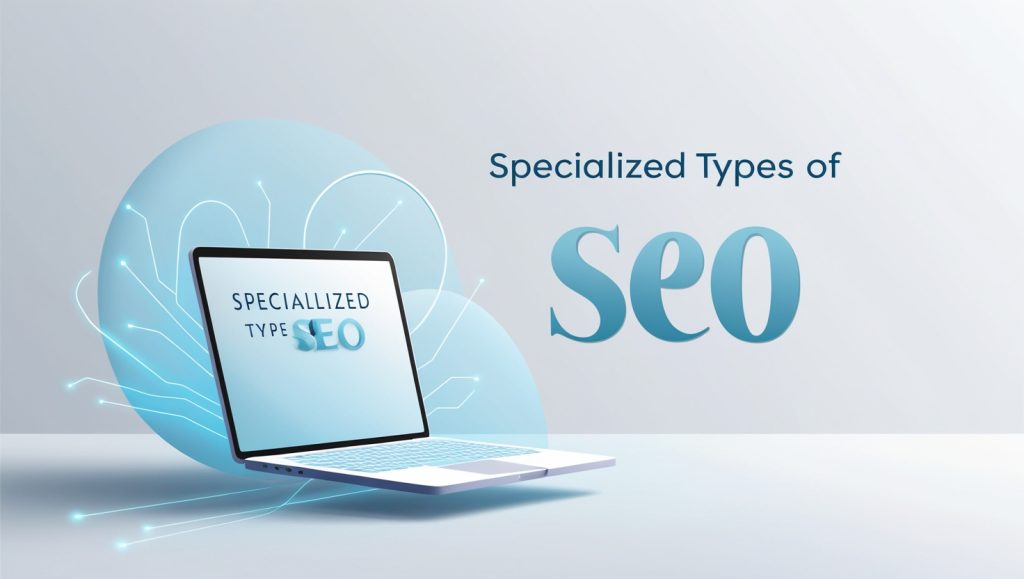
18. Content SEO
Content SEO focuses on creating and optimizing high-quality, relevant content to rank higher in search engine results. It involves:
- Keyword Research: Identifying the right keywords that potential visitors are searching for and incorporating them naturally into your content.
- Content Structure: Ensuring your content is well-organized with headings, subheadings, bullet points, and paragraphs for readability.
- User Intent: Crafting content that addresses the needs and questions of your target audience, enhancing user experience and engagement.
- On-Page Optimization: Optimizing meta titles, descriptions, and tags to align with targeted keywords.
- Content Quality: Prioritizing originality, depth, and value to provide a comprehensive answer to user queries and encourage longer engagement.
19. Social SEO
Social SEO involves optimizing your social media profiles and content to enhance visibility and drive traffic to your website. Key elements include:
- Profile Optimization: Completing and updating social media profiles with relevant keywords and information.
- Content Sharing: Creating engaging content that encourages sharing and interaction, which can indirectly influence search rankings.
- Social Signals: Utilizing likes, shares, comments, and mentions to boost visibility and establish authority.
- Cross-Promotion: Linking social media profiles to your website and other online platforms to improve overall SEO.
- Engagement: Actively interacting with your audience to build a strong online presence and drive more organic traffic.
20. Negative SEO
Negative SEO refers to malicious practices aimed at harming a competitor’s search engine rankings. It involves:
- Link Spam: Creating harmful or low-quality backlinks to a competitor’s site to decrease their authority.
- Content Scraping: Copying content from a competitor’s site and republishing it elsewhere to dilute their content’s originality.
- Fake Reviews: Posting negative reviews or misleading information to damage a competitor’s reputation.
- Hacking: Attempting to hack into a competitor’s site and create harmful redirects or content.
- Defensive Measures: Regularly monitor your backlink profile and site health to identify and address potential negative SEO attacks.
21. Multimedia SEO
Multimedia SEO involves optimizing various types of non-text content, such as images, videos, and audio, to improve search engine visibility. Key aspects include:
- Image Optimization: Using descriptive file names, alt text, and proper compression to enhance image search visibility and loading times.
- Video Optimization: Creating engaging video content with relevant titles, descriptions, and tags, and ensuring proper video sitemaps and schema markup.
- Audio SEO: Optimizing podcasts and audio files with clear titles, descriptions, and transcriptions to improve searchability.
- Multimedia Accessibility: Ensuring all multimedia content is accessible to users with disabilities, can positively impact SEO.
- User Engagement: Encouraging user interaction with multimedia content through social shares, comments, and feedback.
22. Programmatic SEO
Programmatic SEO refers to the use of automated processes and tools to create and optimize large volumes of keyword-targeted pages. Key components include:
- Automation: Using tools to generate content at scale, such as product descriptions or location-based landing pages.
- Data-Driven Strategies: Leveraging data insights to inform content creation and optimization decisions.
- Template Optimization: Creating content templates that can be customized with specific keywords and data for each page.
- Monitoring and Adjusting: Regularly analyzing performance metrics and making adjustments to improve page effectiveness and rankings.
- Efficiency: Streamlining SEO efforts to manage large-scale sites and content more effectively.
Explore our Web Design & Development service and see how we build scalable, SEO-friendly sites.
23. Featured Snippet SEO
Featured Snippet SEO aims to optimize content to appear in the coveted “position zero” in search engine results pages (SERPs). Key strategies include:
- Identifying Target Queries: Researching and targeting common questions that trigger featured snippets.
- Structuring Content: Formatting content with clear, concise answers and using bullet points or numbered lists to increase chances of being featured.
- Schema Markup: Implementing structured data to help search engines understand and present your content as a featured snippet.
- Content Quality: Providing authoritative and well-researched answers that directly address user queries.
- Monitoring Performance: Tracking featured snippet performance and making adjustments based on analytics and feedback.
24. AI SEO
AI SEO involves using artificial intelligence to enhance SEO strategies and processes. Key applications include:
- Content Creation: Utilizing AI tools to generate or assist with content creation based on keyword research and user intent.
- Data Analysis: Analyzing large datasets to uncover insights and trends that inform SEO strategies.
- Personalization: Using AI to tailor content and recommendations to individual user preferences and behaviors.
- Automation: Automating routine SEO tasks, such as keyword tracking and reporting, to improve efficiency.
- Predictive Analytics: Leveraging AI to predict future SEO trends and adjust strategies accordingly.
25. Podcast SEO
Podcast SEO focuses on optimizing podcast content to improve visibility and discoverability through search engines and podcast platforms. Key elements include:
- Title and Description Optimization: Crafting compelling titles and descriptions with relevant keywords to attract listeners and search engines.
- Transcriptions: Providing text transcriptions of podcast episodes to enhance accessibility and searchability.
- Episode Tags: Using tags and categories to help podcast platforms and search engines understand the content and relevance of episodes.
- Show Notes: Create detailed show notes that summarize key points and include relevant keywords and links.
- Promotion: Promoting podcasts through social media, websites, and other channels to increase visibility and drive traffic.
SEO Philosophies
SEO philosophies represent different approaches to optimizing websites for search engines. Understanding these philosophies can help you choose the most suitable strategy for your business goals.

26. White-Hat SEO
White-Hat SEO adheres strictly to search engine guidelines, focusing on creating high-quality content, building relevant backlinks, and optimizing website structure. While it may take longer to see results, this approach is sustainable and less risky. By following ethical practices and providing value to users, White-Hat SEO aims for long-term success and credibility in search engine rankings.
27. Black-Hat SEO
Black-Hat SEO involves using unethical tactics to manipulate search engine rankings. These practices violate search engine guidelines and can result in penalties or website bans. Common Black-Hat techniques include keyword stuffing, link buying, and cloaking. Although these methods might deliver quick gains, they pose significant risks to a website’s reputation and long-term viability.
28. Gray-Hat SEO
Gray-hat SEO falls between White-Hat and Black-Hat SEO, using techniques that are not explicitly prohibited but may be considered questionable. These tactics can yield faster results but also carry risks. Examples of Gray-Hat SEO include using automated tools for link building or participating in link exchange programs. While these methods may be effective, they may not always align with best practices and could potentially lead to issues with search engines.
29. Sustainable SEO
Sustainable SEO focuses on long-term results by building a strong foundation for your website’s online presence. This approach prioritizes creating valuable content, earning natural backlinks, and optimizing user experience. Sustainable SEO is less susceptible to algorithm changes and provides consistent organic traffic. By focusing on ethical and enduring strategies, Sustainable SEO helps maintain and grow your site’s visibility over time.
30. Continuous SEO
Continuous SEO emphasizes the ongoing nature of SEO efforts. It involves regularly monitoring search engine algorithms, analyzing website performance, and adapting strategies accordingly. By staying up-to-date with SEO trends and making continuous improvements, you can maintain and improve your website’s rankings over time. This approach ensures that your SEO practices remain relevant and effective in a constantly evolving digital landscape.
31. Holistic SEO
Holistic SEO considers all aspects of your online presence, including on-page optimization, technical SEO, content marketing, link building, and user experience. By taking a comprehensive approach, you can create a well-rounded SEO strategy that maximizes your website’s potential. Holistic SEO integrates various elements to enhance overall performance, ensuring that all components work together to achieve optimal results.
How to Choose the Right Type of SEO for Your Business
The kind of search engine optimization that will serve your business best is a key factor in deriving the best results. Some of the factors one needs to consider in making decisions are listed below:

- Business Goals: Just spell out what your major goals are. This could be to create more local visibility, penetrate into the global arena, or target a specific audience.
- Target Audience: You need to identify the perfect customer whose behavior is delineated when he or she enters the online world. This will assist you in determining which SEO strategy would be relevant to your business.
- Budget: Evaluate your financials to understand in advance how much should be allocated to the various SEO types.
- Competitor: Understand what your competitors are doing regarding SEO to find opportunities and gaps.
By careful consideration of these factors, you will come up with a customized SEO plan that contributes toward business objectives while maximizing your ROI.
Learn More: Future Trends of SEO
Conclusion
Knowing the types of SEO will help you to build up a strong online presence. Balancing on-page, off-page, technical, and location-based SEO properly will work towards increasing your website’s visibility, attracting more organic traffic, and achieving your business goals.
Keep in mind that search engine optimization is a process and it requires further monitoring for continuous improvement. Keep current on search engines’ algorithms and what’s happening in the industry to keep your edge.
If you’re looking for expert SEO service in Bangladesh to help optimize your website and drive results, visit Khan IT. Our team specializes in comprehensive SEO strategies tailored to your business needs, ensuring long-term success in search rankings and online visibility.
FAQs: Types of SEO
Q: What is the difference between on-page and off-page SEO?
A: On-page SEO focuses on optimizing elements within your website, such as content, keywords, and HTML structure. Off-page SEO involves building external links and improving your website’s reputation.
Q: Is local SEO important for large businesses?
A: While local SEO is particularly beneficial for small businesses, large companies can also benefit from targeting specific geographic locations to increase customer engagement and foot traffic in key areas.
Q: How long does it take to see results from SEO?
A: SEO is a long-term strategy. Results may vary depending on several factors, including competition, website quality, and the implemented SEO tactics. Generally, it can take several months to see significant improvements in search engine rankings.
Q: Should I focus on SEO or pay-per-click (PPC) advertising?
A: Both SEO and PPC advertising have their merits. SEO is a long-term investment that builds organic traffic over time, while PPC offers immediate visibility but requires ongoing budget allocation. A combination of both strategies can often yield the best results.
Q: Can I do SEO myself or should I hire a professional?
A: While you can learn and implement basic SEO techniques yourself, complex SEO strategies often require expertise. Hiring a professional SEO agency like Khan IT can save you time, and effort, and potentially avoid costly mistakes.
Shoaib Santo is an SEO professional with over 7 years of experience and currently serves as the Project Manager at Khan IT. He has shaped the future of digital marketing education by developing course curricula for the Bangladesh Technical Education Board (BTEB). Shoaib also holds NTVQF certifications in Digital Marketing from BTEB and the National Skill Development Authority (NSDA), showcasing his expertise in the industry.
